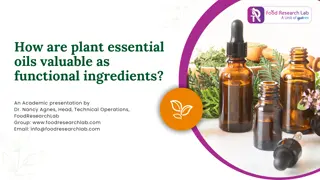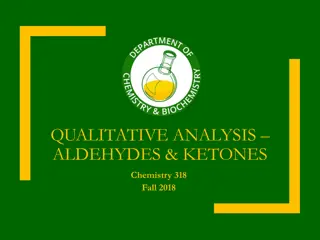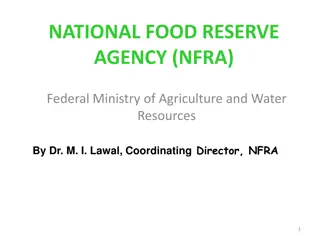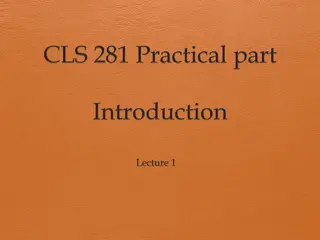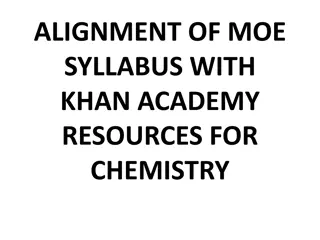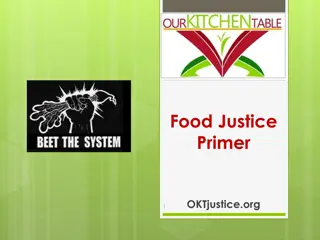Food Chemistry Lab FSTC 313 Rules and Regulations
In the Food Chemistry Lab FSTC 313, students are expected to adhere to strict guidelines regarding attendance, lab safety, late policies, missed lab policies, and technical abstract requirements. The lab emphasizes group work, application notes for the food industry, and individual abstract writing to enhance learning and understanding of food chemistry concepts.
Download Presentation

Please find below an Image/Link to download the presentation.
The content on the website is provided AS IS for your information and personal use only. It may not be sold, licensed, or shared on other websites without obtaining consent from the author. Download presentation by click this link. If you encounter any issues during the download, it is possible that the publisher has removed the file from their server.
E N D
Presentation Transcript
Food Chemistry Lab FSTC 313
Teaching Instructors Eric Casteneda: efrankiec@tamu.edu Helen Sarbazi: zahra74@tamu.edu Mehdi Hashemi: mehdihashemi666@tamu.edu Emma Link (lab coordinator): e.link@tamu.edu
Rules and Regs Students are expected to be on time and attend all laboratory exercises. Anticipated and/or emergency absences should be notified to the instructor as early as possible. Students are expected to be familiar with the topic to be covered prior to entering the lab and to participate in class discussion. Make-up work will only be allowed under strict University guidelines. Lab Safety and General Procedures: General laboratory safety will be covered prior to the first laboratory exercise. Lab coats and closed toe shoes are mandatory for all labs
Rules and Regs Late Policy and Missed Lab Policy Labs are due one week after completion of experiments. Late reports will be penalized 20% per day Unexcused absences = 0 Excused absences will be required to write a 500-word (1 margin, single spaced, 12-pt font) technical literature review (minimum of 5 peer-reviewed references) on the missed lab topic and will be additionally turned in with your lab group to enhance the quality of your lab group s work. Clearly indicate the author of this review and its purpose.
Rules and Regs Food Industry Application Note: Total = 5 All data reports will have an Application Note (AppNote) associated with it. Since all experiments will be conducted in groups, your lab group must come to a consensus on what segment of the food industry you will write your AppNote to. All are group AppNotes except the last one of the semester (individual). So work together, divide the work, and come to a mutual agreement on this information.
Rules and Regs Technical Abstracts: Total = 3 An abstract is a written summary of your work/data, so the entirety of your lab procedures must be expressed in writing. Abstracts will not include graphs, tables, or references but rather a written data description of methods and results. Abstracts will be a minimum of 400 words and a maximum of 500 words using the MSWord word counter. So chose your words carefully. All abstracts will be individual work, and will inherently be unique from the work of your lab group 50% of your total grade is individual abstracts and 50% is AppNotes 1. Justification (~1-2 sentences) 2. Objective (~2-3 sentences) 3. Methods (~3-5 sentences) 4. Results (~5-10 sentences) 5. Significance of your data (~2-3 sentences)
Rules and Regs Notebook and Laboratory Exam: You will keep a formal lab notebook for this lab. Any BOUND lab book format is fine. Lab books will be checked periodically throughout the semester. A mid-term lab exam will be given covering material up to and including that day s lab. Take good notes and be organized throughout the semester to aid you in preparation.
Rules and Regs To write a good abstract, you need good notes. Take notes in your lab book and write about the following 5 points: 1. Motivation. Why do we care about the problem? 2. Problem statement. What problem are you trying to solve or understand? 3. Approach. How did you go about solving the problem? 4. Results. What's the conclusion of your experiments? 5. Conclusions. What are the implications of your data?
What to Turn In Each written assignment will have a cover page. Title of the assignment Names of everyone in the lab group. Signature of each lab group member next to your name. Your signature indicates you are in agreement with the work turned in. Assignments will not be accepted without the signature of all lab group members. Staple all pages together and turn in as a lab group.
Grades Application Notes (2 @ 50 pts each) = 100 pts Abstract/AppNote (3 @ 100 pts each) = 300 pts Laboratory notebook Lab Exam Total = 50 pts = 50 pts = 500 pts
Lab Safety and Procedures Your safety and those around you are our #1 concern. Watch out for yourself and others. The instructors will show you how equipment works, but if you don t know don t assume. Ask take your time we will show you how.
This is a W-Course Up to 70% of your grade will be based on how your write about your experiments and results. Your AppNotes and Abstracts will be graded on clarity of thought and technical interpretation. We will cover writing techniques before labs. You will not be able to write well, if you don t read literature in your field.
Find a Lab Partner I can choose your lab partner. I reserve the right to change lab partners at ANY time for ANY reason. If you have an issue with your lab partner, first try to resolve, try again, and then let a TA know. There are times when it may be advantageous to combine lab groups to run larger, more complicated experiments. Exchange contact information.
What is Food Chem Lab? We will study reactions in foods. Getting the right answer is not a requirement of this class. You must critically think about your lab. You must come prepared for the lab. Many labs you will have experimental options that require thought followed by action. You will need time to evaluate your results and re-test your experiment to confirm.
1) Adsorbed water is water that associates in layers via intermolecular bonds around hydrophilic food molecules, monolayer 2) Bound water is tightly bound water, does not exhibit colligative properties 3) Free water is lightly trapped and easily removed from food material
Water activity Important in food preservation and safety Definitions - Availability of water to enter chemical and enzymatic reactions. -Represents the degree to which the bound water in a food is tied up and unavailable for chemical reactions or microbial growth -Relationship between loss of quality and moisture content
A general rule of thumb: As the percentage of bound water in a food increases, the water activity decreases Aw = P/ Po P= Vapor pressure of a food Po= Vapor pressure of pure water (1.0) Aw scale is from (0.0 to 1.0) All foods have a water activity less than 1.0; the higher the water activity the more perishable the food item is likely to be
Desorption wet material placed in a dry environment Foods lose moisture, water activity decreases Important in drying or concentration food processing Adsorption- Dry material placed in a wet environment Foods gain moisture, water activity increases Hygroscopic foods absorb moisture
FREE BOUND ADSORBED
Someone make a simple table on the white board Food/Solution Predicted Aw Actual Aw


